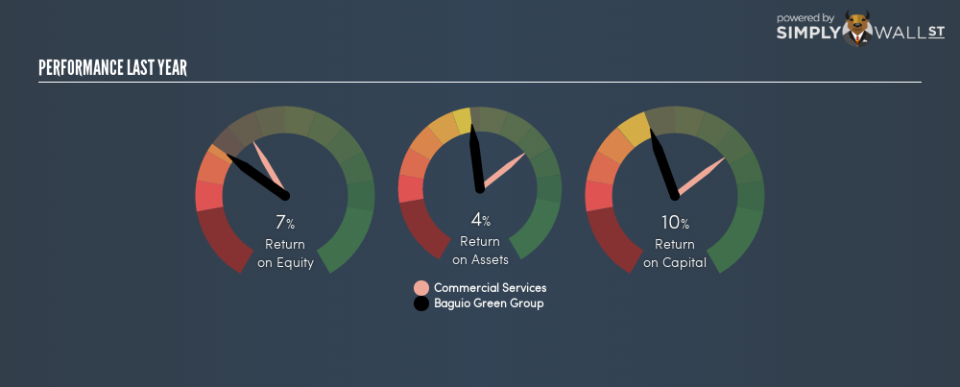Is Baguio Green Group Limited’s (HKG:1397) 9.6% Return On Capital Employed Good News?

Want to participate in a short research study? Help shape the future of investing tools and you could win a $250 gift card!
Today we’ll evaluate Baguio Green Group Limited (HKG:1397) to determine whether it could have potential as an investment idea. In particular, we’ll consider its Return On Capital Employed (ROCE), as that can give us insight into how profitably the company is able to employ capital in its business.
First up, we’ll look at what ROCE is and how we calculate it. Second, we’ll look at its ROCE compared to similar companies. And finally, we’ll look at how its current liabilities are impacting its ROCE.
What is Return On Capital Employed (ROCE)?
ROCE measures the amount of pre-tax profits a company can generate from the capital employed in its business. In general, businesses with a higher ROCE are usually better quality. In brief, it is a useful tool, but it is not without drawbacks. Author Edwin Whiting says to be careful when comparing the ROCE of different businesses, since ‘No two businesses are exactly alike.’
How Do You Calculate Return On Capital Employed?
Analysts use this formula to calculate return on capital employed:
Return on Capital Employed = Earnings Before Interest and Tax (EBIT) ÷ (Total Assets – Current Liabilities)
Or for Baguio Green Group:
0.096 = HK$30m ÷ (HK$603m – HK$328m) (Based on the trailing twelve months to June 2018.)
Therefore, Baguio Green Group has an ROCE of 9.6%.
See our latest analysis for Baguio Green Group
Is Baguio Green Group’s ROCE Good?
ROCE is commonly used for comparing the performance of similar businesses. It appears that Baguio Green Group’s ROCE is fairly close to the Commercial Services industry average of 11%. Setting aside the industry comparison for now, Baguio Green Group’s ROCE is mediocre in absolute terms, considering the risk of investing in stocks versus the safety of a bank account. Investors may wish to consider higher-performing investments.
As we can see, Baguio Green Group currently has an ROCE of 9.6%, less than the 18% it reported 3 years ago. Therefore we wonder if the company is facing new headwinds.
When considering this metric, keep in mind that it is backwards looking, and not necessarily predictive. Companies in cyclical industries can be difficult to understand using ROCE, as returns typically look high during boom times, and low during busts. ROCE is only a point-in-time measure. If Baguio Green Group is cyclical, it could make sense to check out this free graph of past earnings, revenue and cash flow.
Baguio Green Group’s Current Liabilities And Their Impact On Its ROCE
Current liabilities are short term bills and invoices that need to be paid in 12 months or less. Due to the way the ROCE equation works, having large bills due in the near term can make it look as though a company has less capital employed, and thus a higher ROCE than usual. To check the impact of this, we calculate if a company has high current liabilities relative to its total assets.
Baguio Green Group has total liabilities of HK$328m and total assets of HK$603m. Therefore its current liabilities are equivalent to approximately 54% of its total assets. Baguio Green Group has a fairly high level of current liabilities, meaningfully impacting its ROCE.
What We Can Learn From Baguio Green Group’s ROCE
Notably, it also has a mediocre ROCE, which to my mind is not an appealing combination. Of course you might be able to find a better stock than Baguio Green Group. So you may wish to see this free collection of other companies that have grown earnings strongly.
If you like to buy stocks alongside management, then you might just love this free list of companies. (Hint: insiders have been buying them).
To help readers see past the short term volatility of the financial market, we aim to bring you a long-term focused research analysis purely driven by fundamental data. Note that our analysis does not factor in the latest price-sensitive company announcements.
The author is an independent contributor and at the time of publication had no position in the stocks mentioned. For errors that warrant correction please contact the editor at editorial-team@simplywallst.com.

